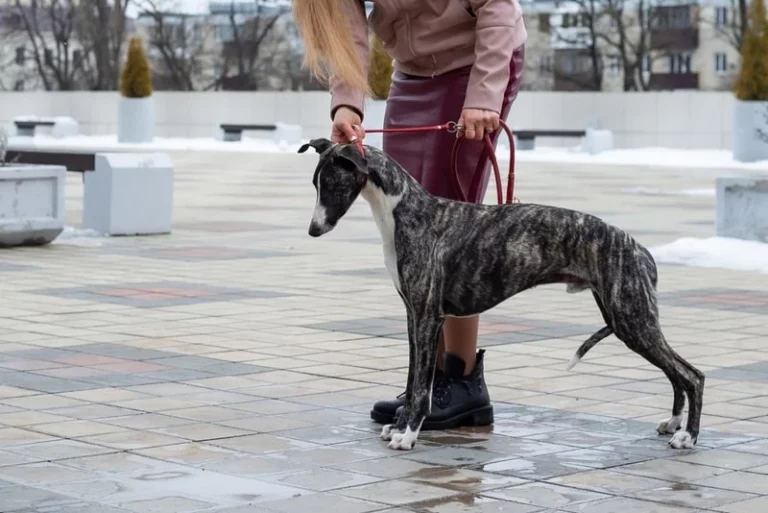Whippet Dog Breed: From American Whippet Club
The Whippet is a medium-sized dog breed that combines grace and speed in its slender frame. These dogs were initially bred to hunt using their keen sight, contributing to their impressive bursts of speed and graceful movements. They are a common sight in dog races and shows because of these abilities. Whippets stand between 18 and 22 inches tall at the shoulder and weigh between 25 and 40 pounds. They have a smooth, short coat that can appear in various colors and patterns.
Known for being gentle and loving, Whippets make great family pets and fit well in home settings. They need physical activities and mental challenges to stay happy and cherish their downtime. You’ll often find them snuggling up in a warm spot for a nap.
To ensure you get a healthy Whippet, always buy from reputable breeders. Good breeding helps prevent common genetic issues and supports the overall welfare of these dogs.
Key Takeaways
- Whippets excel in speed with a graceful build.
- These dogs bond well with families, enjoying activity and relaxation.
- Buy from trusted breeders to ensure a healthy Whippet.
Quick Facts
Whippets stand out with strength and grace, known for their agility and speed. These dogs boast a muscular yet streamlined body, ideally suited for quick sprints when chasing prey. Bred for their ability to perform, Whippets merge the resilience of their forebears with an elegant look, placing them prominently within the Hound Group.
Born out of 18th-century England, these dogs were originally developed to hunt and were incredibly swift at catching rabbits. Their form results from generations of selective breeding, which has produced a breed capable of remarkable athleticism and lasting stamina.
Whippet Dog Pictures
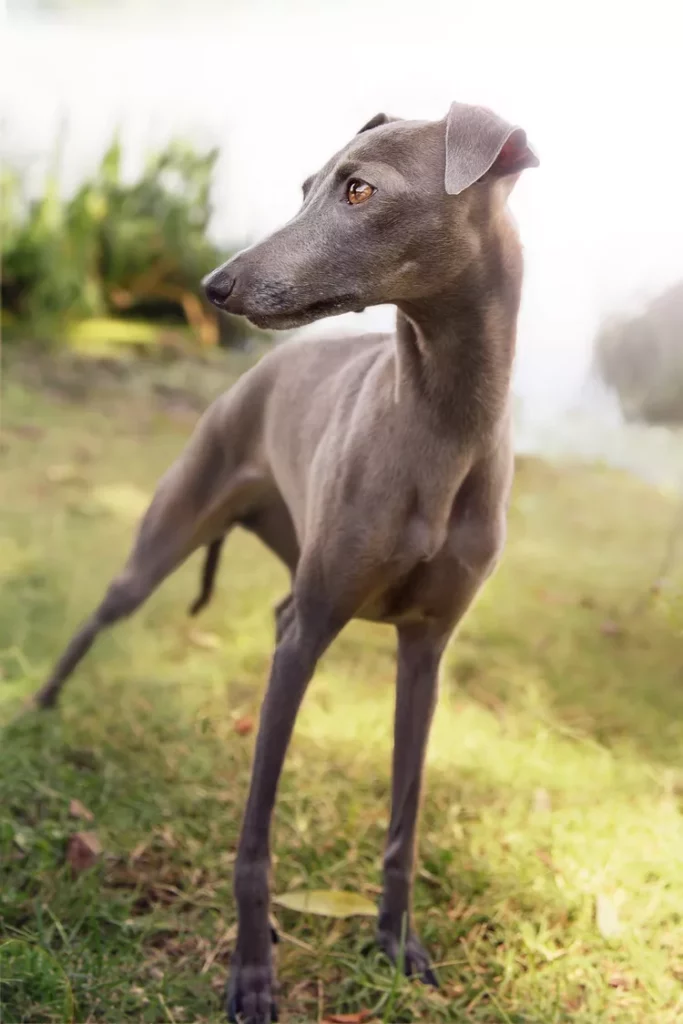
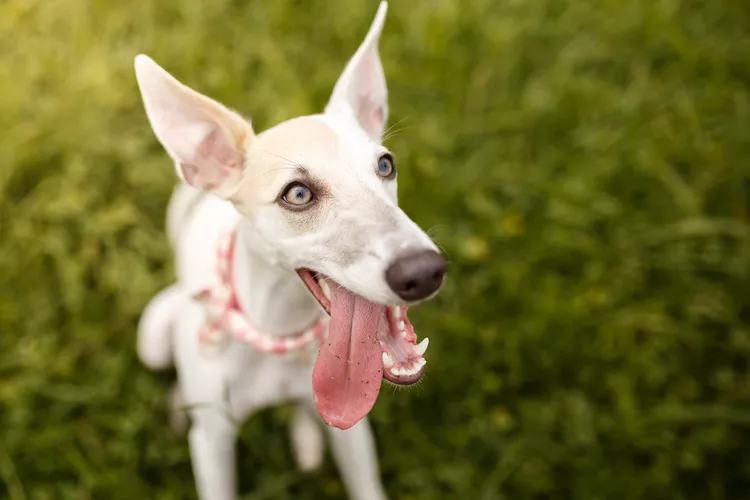
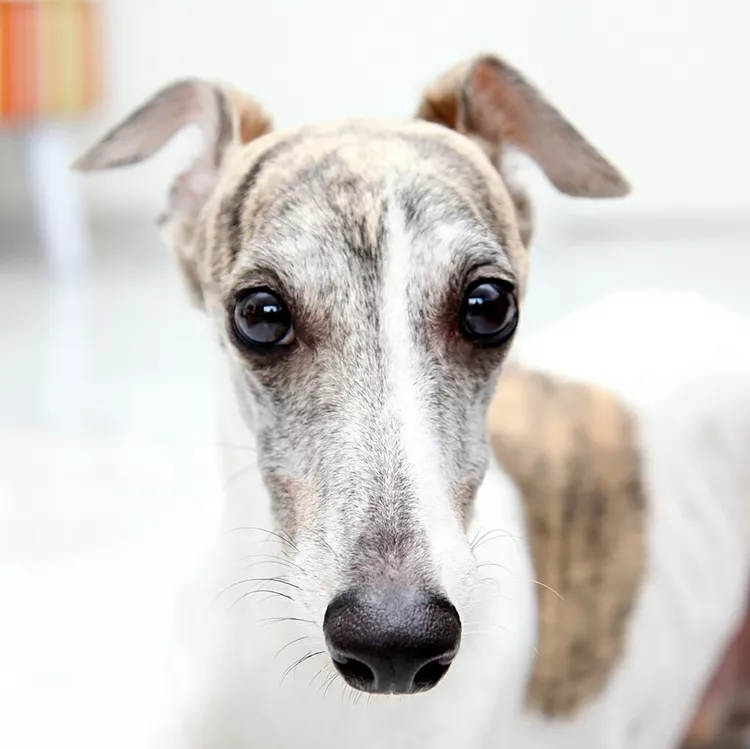

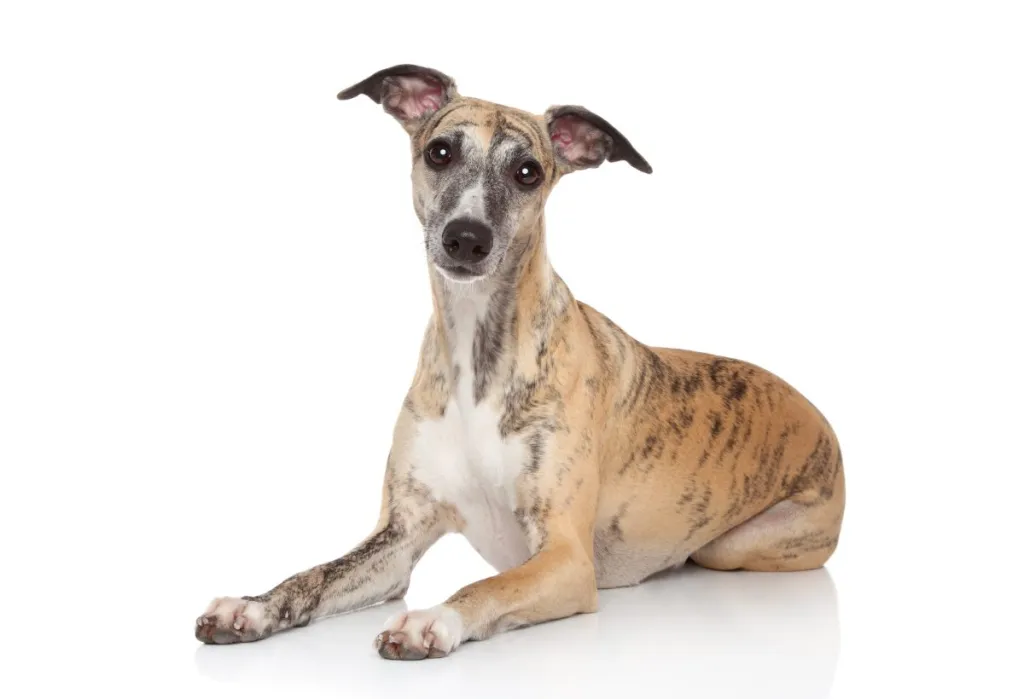
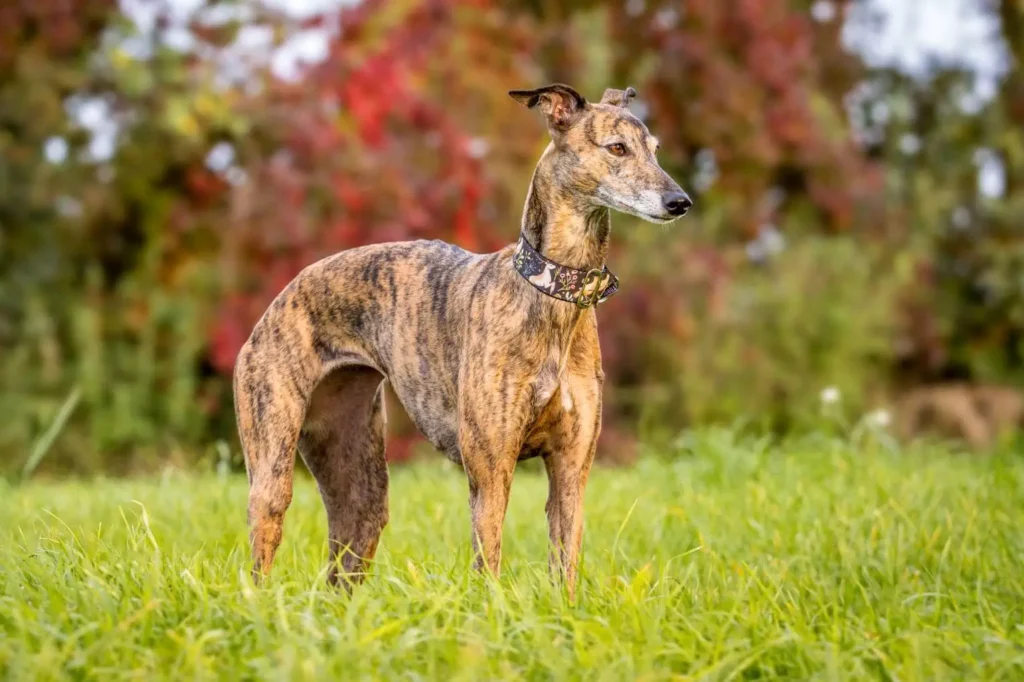
Overview
Whippets are known for their speed, agility, and affectionate nature, making them ideal pets and skilled sports dogs. The American Kennel Club officially recognizes them, and they have a sleek physique, allowing them to run at high speeds, much like their larger relative, the greyhound.
Whippets were historically used for hunting, particularly for catching rabbits, and today, they still have a strong instinct to run and chase. However, despite their sporting abilities, Whippets are also great indoor pets and enjoy forming close relationships with their owners.
They are a unique dog breed that can excel in athletic events or be happy just lounging on a cozy sofa at home.
Key Traits
Whippets are peaceful at home but shine with speed and agility outdoors, traits honed from their sighthound lineage. Their sleek bodies enable them to chase swiftly and maneuver with ease, making them both excellent hunters and competitive racers.
These dogs are also known for being patient and gentle with kids, making them great family pets. Their low-maintenance, short coats require very little grooming.
Whippets need environments where they can sprint regularly, and due to their strong prey drive, keeping them leashed or enclosed spaces is safer. They thrive in homes where they can get enough exercise and room to move around, aligning with their physical activity needs.
Breed Origin
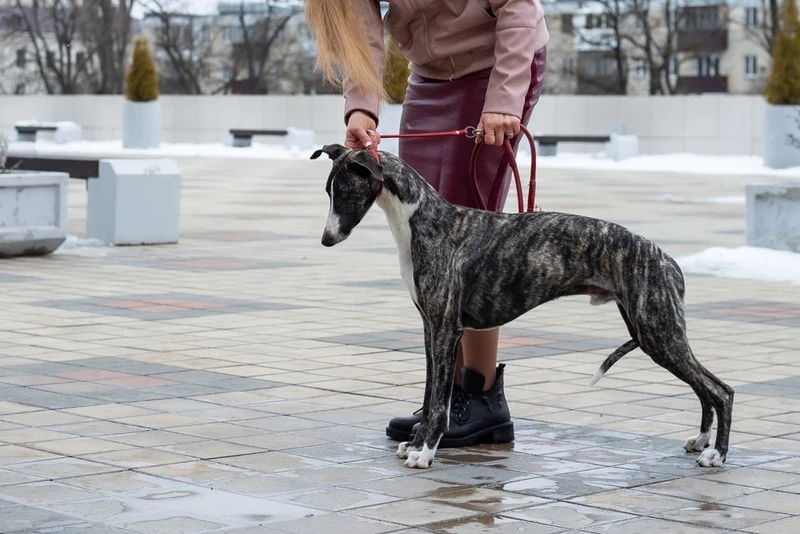
The Whippet has a fascinating history; it was born in 18th century Great Britain from a cross between the swift Greyhound and the diminutive Italian Greyhound. This combination was perfect for creating a dog that excelled in rabbit hunting and track racing, molding the Whippet into the quick and friendly breed we appreciate today.
Known for their lean and robust build, they echo the physical traits of their Greyhound relatives.
Born in the British working-class environment, these dogs were valued for their speed and skill.
Their focused stare reflects a history of chasing after small prey with great intensity.
The Whippet’s rapid movement in pursuit is a testament to their athletic nature.
Their ancestry tells stories of diverse backgrounds, from high society’s luxury to working-class sports’ raw competitiveness.
Ancestral Lineage
The Whippet breed has roots in 18th-century Great Britain, born from the innovative crossbreeding of Greyhounds with more miniature terriers. In their quest for an elegant yet capable hunting companion, Miners were critical to the breed’s development. The species owes much of its speed and agility to the strong Greyhound genes.
Some believe that Italian greyhounds played a role in refining the Whippet’s streamlined shape, giving it a balanced blend of grace and quickness. The harsh conditions of Northern England were the perfect proving grounds for the Whippet, sharpening its instinct for the chase.
This careful breeding for speed and hunting abilities established the Whippet’s ancestral lineage, creating a breed that excels in appearance and performance.
Historical Purpose
In the 1700s, Great Britain saw the rise of the Whippet, a breed known for its impressive speed and agility. These dogs became essential for those needing to hunt rabbits efficiently, especially families relying on hunting for sustenance.
Known as the affordable relative of the Greyhound, Whippets were embraced by many for their ability to perform similar tasks without the high costs. They also excelled in rag-racing events, where they chased after moving targets, which mirrored the skills needed for hunting small game that helped them become a valued part of the sporting dog community.
Geographic Beginnings
Whippets have a rich heritage originating from the coal-mining areas of Northern England, where they were bred during the 18th century. Being a smaller relative of the Greyhound, these dogs were mixed with terriers to withstand the harsh and cold climate of the mines.
Whippets were valued for their lean physique and sharp hunting abilities, making them perfect for chasing game – a vital activity for miners who needed extra food. After the Kennel Club gave the breed official recognition, it wasn’t just their practical qualities celebrated but also their growing popularity in dog racing.
Each Whippet carries the resilient and agile qualities inherited from their ancestors, shaped by both the harsh environments and the needs of their human companions.
Physical Dimensions
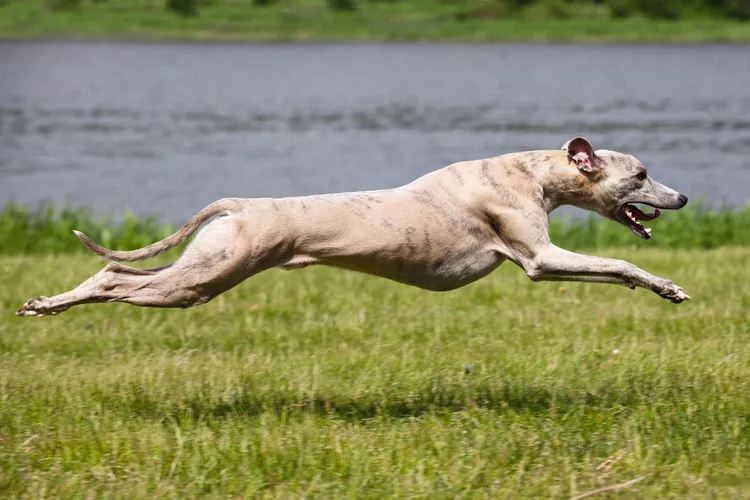
Whippets are known for their slim, athletic build, a vital part of the breed’s standards. This build contributes to their impressive speed and agility, making them famous for racing and hunting.
They stand at a height that places them in the medium-sized dog category and have a body weight that’s perfectly balanced to support both their skill and strength.
Their appearance is reminiscent of a smaller Greyhound, highlighting their shared heritage and similar use in sports. Whippets have coats that vary from one dog to another, ranging from smooth and shiny to a bit coarser, each adding to the dog’s visual charm.
Size charts for dogs often showcase Whippets among a varied lineup, helping owners understand where these graceful animals fit within the dog size spectrum.
Height and Weight
Whippets are known for their graceful and athletic build, typically standing 19-22 inches for males and 18-21 inches for females. Their weight ranges from 25 to 40 pounds, reflecting their lean physique. It’s not just about looks; their height at the shoulders is vital for their agility and speed.
Keeping a whippet at a healthy weight is a sign of a good diet and regular exercise, which are vital for their physical well-being. An overweight whippet can encounter health problems, as extra weight can put stress on their heart and joints. Owners should closely monitor their pets’ food intake and activity levels to ensure they stay fit and fast.
Slim Athletic Build
Whippets have a slim and athletic build that’s visually striking and functional. Their slender bodies support their impressive speed and agility, making them stand out in activities that require quick movement.
Male whippets typically stand 19-22 inches tall, while females measure 18-21 inches, a size that contributes to their explosive bursts of speed, which was vital in their past as racing and hunting dogs.
These dogs weigh between 25 and 40 pounds, a weight range contributing to their endurance and nimble movement throughout their expected 12-15-year lifespan.
Coat Texture Variations
Whippets possess a distinctive athletic build, but their coat’s texture is just as noteworthy. They have short, smooth, and delicate skin that’s easy to care for, requiring only simple grooming. This coat clings to their slim body, aiding their fast movement.
Regular brushing once a week keeps their shedding low and their fur shiny. Whippets thrive with this easy-care approach if their diet and housing are suitable. However, due to their thin coats, they often need extra warmth in cold weather, so a coat or sweater for your Whippet is a wise choice to keep them comfortable.
Standard Breed Measurements
Whippets are known for their elegant stature, with males typically standing 19 to 22 inches at the shoulder, while females tend to be a bit smaller at 18 to 21 inches. The weight for a healthy adult Whippet should fall between 25 and 40 pounds, with females usually weighing around 29 pounds and males about 34 pounds.
This medium size contributes to their streamlined appearance, a distinctive feature of Whippets. Sticking to these size and weight guidelines is essential for the dog’s overall health and to keep the breed’s sleek look intact. If a Whippet strays far from these measurements, it could indicate health issues or a move away from the breed’s standard, affecting the dog’s quality of life and suitability for breed-specific activities.
Size Comparison Chart
Whippets typically fall into a distinct size category that sets them apart from other dog breeds. A comparison chart would show that they are more significant than toy breeds but considerably smaller than Great Danes or Mastiffs.
Male Whippets usually stand about 19-22 inches tall, while females range from 18-21 inches, giving them a sleek and streamlined appearance. They weigh in at a moderate 25-40 pounds, heavier than many small breeds but far less than the more oversized guard and working dogs.
This size makes Whippets ideal companions for cozy home environments and outdoor adventures, evident in their agile movement and energetic nature.
Temperament Traits
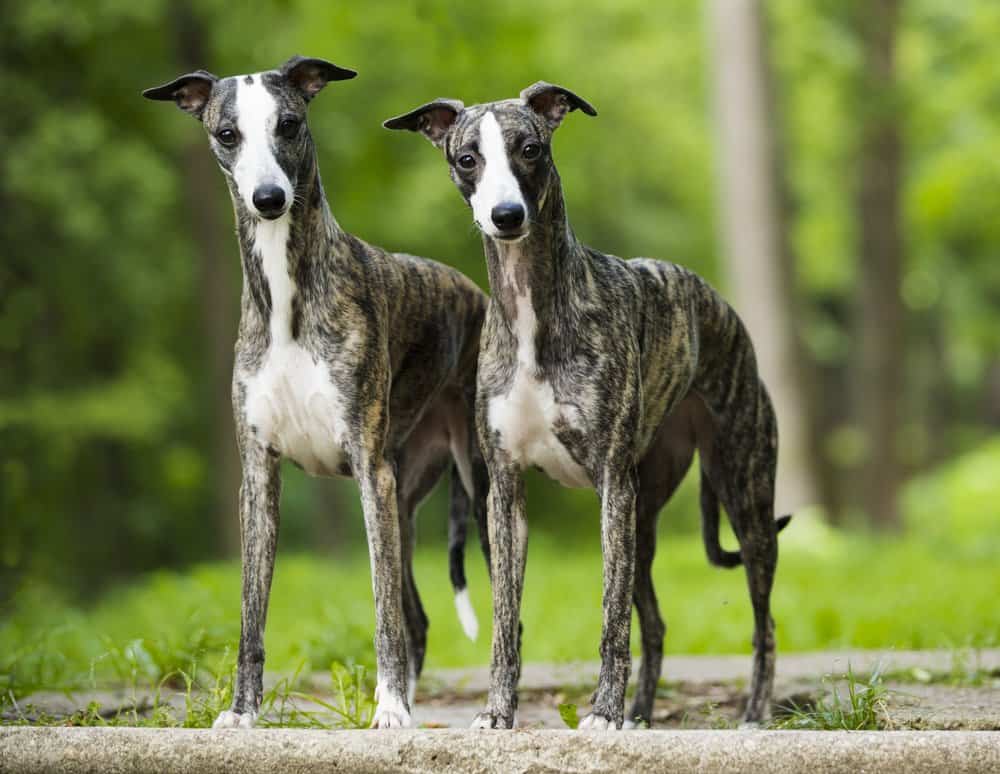
Whippets possess a dynamic temperament that makes them excellent companions for various lifestyles. They are known for their gentle nature and love of vigorous play, providing the best of both worlds as a calming force in the house and an active buddy outdoors. Whippets are affectionate with their families but enjoy their independence, which speaks to their ability to adapt and care for themselves. Their quiet and easygoing behavior is ideal for those who prefer a serene home environment.
Picture a Whippet peacefully resting by its owner, the image of relaxation. Then, imagine the same dog dashing across a field in a lively game of fetch. They are also tender and careful when playing with children, which reflects their soft-hearted character. These dogs often entertain themselves with puzzle toys, showing their independent side. When they’re not playing or cuddling, Whippets can usually be found sitting quietly, taking in their surroundings with a gentle look.
Gentle Disposition
Whippets are known for their serene temperament and kindness towards people and animals. They make excellent family pets, fitting in well with the home environment and winning hearts with their generous nature.
Though they come from a racing background, Whippets are calm and peaceful, especially inside a home. They get along well with other dogs, creating a friendly setting perfect for homes with multiple pets.
These dogs value close relationships with their families, showing a lot of love, but they’re not the best choice if you’re looking for a guard dog. Whippets need affection and are better suited as loving companions.
Energetic Playfulness
Whippets may seem calm indoors, but take them outside, and they burst into life with enthusiastic energy. These dogs need daily exercise, including plenty of walks and playtime, to stay happy.
When whippets chase and run, they’re not just burning off energy but following their instinct for vigorous activity. Watch a whippet sprint across a field, and you’ll understand how vital exercise is for them—it’s how they stay balanced and peaceful at home.
A whippet that gets enough playtime is a joy, showing just how content they can be when their exercise needs are met.
Affectionate Behavior
After a lively play session outdoors, whippets become noticeably gentle and loving when they return inside. They often express their fondness by cuddling up close or even lying across their owners’ laps. Whippets show affection with soft looks, a friendly tail wag, and quiet nudges for attention, which speaks to their respectful and charming nature.
They are in tune with their home’s atmosphere and adjust their behavior to match it, making them excellent pets for those who appreciate calmness and companionship. Observing a whippet, you’ll see they are happy to give love without needing constant back-and-forth, fitting perfectly into peaceful homes.
Independent Streak
Whippet owners often notice their dogs have a loving personality and a strong desire for independence. This trait means they might not always follow commands immediately. For successful training, offering rewards and a calm, consistent approach works best, appealing to the Whippet’s ‘what’s in it for me?’ attitude.
While they enjoy their alone time and can handle short periods of solitude, leaving them alone for too long isn’t ideal. Finding the right mix of companionship and allowing them their freedom is essential, which is critical to keeping these sensitive dogs happy.
Quiet Nature
Whippets are known for their peaceful and gentle nature, often enjoying quiet moments that show their calm personality. They have a perfect mix of energy and relaxation, never too loud or shy. These dogs are ideal for those who want a pet that loves to lounge and relax at home. Whippets ask for little, rarely make noise, and carry themselves gracefully inside.
Despite their love for relaxation, Whippets still need daily walks or playtime to stay happy and healthy. After getting enough exercise, they’re so glad to return to their default state of rest, making them great pets for a relaxed home environment.
Health Concerns & Prevention
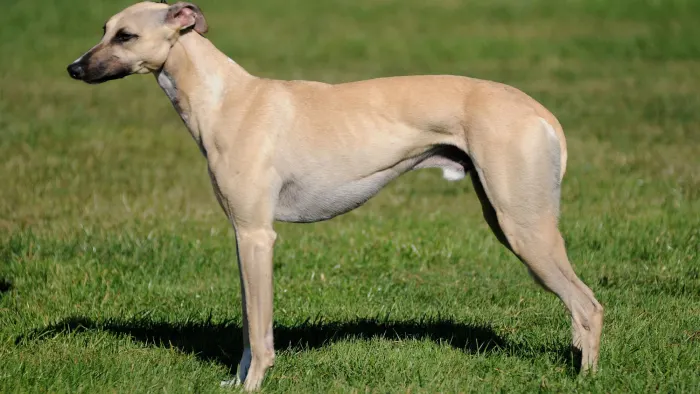
Whippets can have specific health issues that owners must watch out for, including ailments more common in the breed. Preventing these health problems is vital and can impact your Whippet’s lifespan and well-being.
Knowing about genetics plays a crucial role in breeding to reduce hereditary diseases in puppies.
Health checks like cardiovascular screenings can catch early signs of heart problems. Eyes should be checked regularly to protect against worsening vision. Hip exams are essential to spot dysplasia early, and genetic tests can alert owners to conditions that whippets might face.
Also, whippets need special care with anesthesia due to their particular sensitivities.
Common Whippet Ailments
Although generally hardy, Whippets are predisposed to specific health conditions that owners must be aware of. These slender dogs must stay lean since excess weight can lead to more severe health issues. They may inherit hip dysplasia, which makes responsible breeding and early genetic testing for this and other conditions such as deafness, hypothyroidism, heart problems, and eye defects crucial for their well-being. Regular vet visits are essential for Whippets, mainly because they have a known sensitivity to anesthesia and certain drugs, so finding a vet experienced with sighthounds is necessary.
A less common genetic disorder in Whippets is Bully Whippet Syndrome, highlighting the need for thorough genetic screening. Regular physical activity, a balanced diet, and a calm living space are vital to keep Whippets healthy. These practices help prevent health issues and ensure a happy life for these dogs.
Preventative Health Measures
To keep Whippets healthy, owners should take specific steps that address the breed’s unique health needs.
Genetic testing is crucial for spotting Bully Whippet Syndrome early, which can significantly alter a dog’s muscle development.
A balanced diet is vital for these slim dogs to keep them at a healthy weight, which is a critical part of their overall health.
Regular vet check-ups are essential to catch any health problems before they become serious.
Even though Whippets don’t need much grooming, routine care like brushing once a week and trimming nails when required is essential for their well-being.
Lifespan and Genetics
Whippets typically live between 12 and 15 years, but like all breeds, they can inherit specific health problems. Ranked as the 81st breed by the American Kennel Club, the Whippet is known for its graceful lines and impressive speed. These dogs, however, may face health issues related to their genetics. Good breeders take steps to screen for conditions such as hip dysplasia, deafness, hypothyroidism, and heart problems to ensure the breed’s well-being.
It’s crucial to have Whippets undergo regular health checks, including eye exams, for early detection of potential health issues. Keeping an eye on their weight is also important because their slim frame is at risk of conditions like Bully Whippet Syndrome. Taking proactive steps in health care is critical to ensuring a healthy life for a Whippet.
Whippet Maintenance Needs
Caring for a Whippet involves several aspects to ensure their health and happiness. These include exercise, a balanced diet, grooming, regular check-ups, and consistent training.
Whippets need exercise because of their unique body shape and quick metabolism. They require energetic daily activities that match their need for speed and endurance.
A balanced diet is vital for Whippets, considering their slender build and high energy levels. Their food should meet their specific energy needs to help maintain their overall health.
Grooming for Whippets is relatively simple as their smooth, short fur is low maintenance. Occasional brushing can benefit their coat and keep it looking shiny.
Regular check-ups are vital to preventing health problems that Whippets may be prone to. Routine health check-ups can help catch any issues early on and ensure their well-being.
Consistent training is necessary for Whippets to keep their minds sharp and utilize their natural speed and agility. Continuous training can help harness their innovative and agile nature.
Grooming Frequency
Whippets are known for their easy-to-care-for coats, but weekly brushing is recommended to maintain their shiny and healthy appearance.
A simple tool like a rubber curry brush or hound glove does the trick and helps strengthen the relationship between you and your pet, which is beneficial for training.
Consistent grooming routines help dogs feel secure and can improve their learning during training sessions.
While grooming a Whippet is straightforward, it’s also essential to pay attention to their health, including their known sensitivities to certain medications, to ensure they stay happy and healthy.
Exercise Requirements
Whippets need about 40 minutes of exercise daily due to their energetic nature, which keeps them physically and mentally fit. Mixing different activities, such as leisurely walks for mental engagement and bursts of running for their natural hunting instincts, is beneficial.
These exercise routines do more than tire them out; they help prevent anxiety and unwanted behaviors caused by excess energy. Ensuring your Whippet gets enough physical activity is critical to avoiding restlessness and maintaining happiness.
Nutritional Needs
After their daily workouts, Whippets need a well-measured diet of 1 to 1.5 cups of high-quality dry food. This diet supports their health and helps maintain their energy and muscle.
Tailoring the food amount to each dog’s unique metabolism and activity is essential to prevent under and overfeeding. Since Whippets can quickly gain weight, keeping their diet in check is critical.
Regular vet visits are also a smart move to keep an eye on their health and make diet adjustments when needed, ensuring they get the proper nutrients for a long and vibrant life.
Health Check Schedule
Regular vet visits are essential for a Whippet’s lifelong health. Puppies and adult dogs need these check-ups to catch and prevent breed-specific health issues. The Whippet Club suggests a schedule that includes genetic screening for inherited problems such as hip dysplasia and deafness.
These visits should also check for thyroid and heart conditions, helping maintain the Whippet’s well-being.
Dental care is another critical aspect, with regular cleanings to prevent tooth and gum diseases.
Maintaining a Whippet also involves careful grooming and a diet tailored to their needs, which keeps them healthy and happy for years.
Training Commitment
Training a Whippet requires time and commitment from the owner due to their energetic nature and instinct to chase. You’ll need a customized training plan that addresses these traits to prevent mischievous behavior, especially in young dogs.
Establishing a regular training routine is critical, and it’s best if all family members are involved to maintain consistency in commands and interactions. This helps create a stable, peaceful home environment.
Whippets respond best to a gentle and positive approach, as harsh methods can scare them. A well-behaved Whippet reflects the owner’s dedication, patience, and understanding.
Dietary Requirements
Whippets have specific dietary needs that keep them healthy and full of energy. It is vital to choose the right food to give them the nutrients they need for their fast metabolism. Knowing which foods are best for dogs with allergies and sticking to a regular feeding schedule is critical to their health and happiness.
For an active breed like the Whippet, high-protein dog food is ideal. If your Whippet has a sensitive stomach, look for hypoallergenic foods. Consistent meal times help manage their energy levels and support good digestion. Ingredients that are rich in nutrients can help maintain their muscles and joints. It’s also essential to match their calorie intake to how much exercise they get.
Remember to look for dog food designed for active breeds and consider hypoallergenic options if your pet has allergies. Keep mealtimes regular to support your Whippet’s digestion and energy. Include foods that help muscle and joint health and balance their caloric intake with their activity level.
Optimal Food Choices
Choosing the proper diet for a Whippet is vital to keeping them healthy and fit. A high-quality dry food that balances nutrition is ideal for these energetic dogs, providing enough protein for strong muscles, fats for sustained energy, and carbohydrates for lasting stamina.
If a Whippet’s exercise is limited due to living in a smaller space, like an apartment, it’s important to adjust their food portions to avoid weight gain. Since excess weight can harm their health and agility, monitoring their calorie intake is essential.
A diet with vitamins and minerals will support a Whippet’s quick metabolism and physical health.
Allergy-Specific Diets
Whippets, like all dogs, may have allergies or food intolerances that can impact their health. To keep a Whippet healthy, paying close attention to how they respond to different foods is crucial, as allergies could cause skin rashes, stomach problems, or breathing difficulties.
New Whippet owners should know that they might need to provide special diets for their pets. This could mean finding alternative proteins or using hypoallergenic food that avoids known allergens. Identifying and removing the harmful ingredients from their diet is vital to keeping the dog healthy and full of energy.
Feeding Frequency Guidelines
When setting up a meal schedule for your Whippet, it’s recommended to feed them twice daily to match their nutritional needs with their energy levels.
An adult Whippet typically does well on 1 to 1.5 cups of premium dry food divided between two meals, ensuring they get the right amount at regular intervals.
Adjusting the portion size to your dog’s specific characteristics, such as their weight, age, metabolism, and how much they exercise, is critical to maintaining their health.
It’s crucial for owners to closely monitor their Whippet’s diet to avoid the risks of underfeeding or overfeeding.
Whippets that are more active will definitely need more food than those who spend most of their time lounging around, so keep an eye on their activity and adjust their diet accordingly.
How to Groom a Whippet
Grooming Tools and Techniques
Due to their short coats, whippets are relatively low-maintenance when grooming. They require regular brushing with a soft bristle brush to remove loose hair and keep their coat sleek and shiny. Additionally, a grooming mitt can help maintain their coat and skin health.
Bathing and Coat Care
Whippets are generally clean dogs and do not require frequent bathing. When bathing, they must use a mild dog shampoo and thoroughly dry their coat to prevent skin issues. Their ears should also be checked and cleaned regularly to avoid potential infections.
Nail Trimming and Ear Cleaning
Regular nail trimming is essential for whippets to prevent overgrowth and potential discomfort. Furthermore, routine ear cleaning using a dog-friendly ear solution helps keep their ears healthy and free from wax buildup.
Understanding the High Prey Drive of Whippets
Training Tips for Managing Prey Drive
Whippets have a strong prey drive due to their historical purpose as hunters. Pet parents must provide structured training that positively channels this instinct. Positive reinforcement techniques and engaging in activities such as lure coursing can help them manage their instincts.
Exercising and Stimulating a Whippet’s Natural Instincts
To fulfill their need for physical and mental stimulation, whippets should exercise regularly through activities like brisk walks, runs in a secure area, and interactive play. Engaging in dog sports like agility and obedience trials can provide mental challenges that match their intelligence.
Behavioral Issues Related to Prey Drive
If not adequately stimulated and managed, whippets with a high prey drive may exhibit undesirable behaviors such as chasing small animals or attempting to escape from enclosed areas. Supervision and a secure fence are essential to ensure their safety and prevent potential escape attempts.
Whippet Breed Standard and AKC Recognition
How to Find a Reputable Whippet Breeder
When considering a whippet, it is essential to seek a responsible breeder who prioritizes the health and well-being of the breed. Researching reputable kennel clubs and breed-spewell-beingnizations can help pet parents find trustworthy whippet breeders who adhere to ethical breeding standards and practice health testing.
Comparison with Other Similar Breeds like Greyhounds and Italian Greyhounds
Whippets, greyhounds, and Italian greyhounds are all sighthounds, sharing similar traits such as speed, endurance, and a strong prey drive. However, they differ in size, with whippets being medium-sized, making them suitable for families seeking a smaller sighthound companion.
Participating in AKC Events and Competitions
Whippets are recognized by the American Kennel Club (AKC) and are eligible to participate in various dog events and competitions, including conformation shows, lure coursing, and agility trials. These events offer opportunities for pet parents to showcase the breed’s abilities and to connect with other whippet enthusiasts.
Tips for Whippet Pet Parents
Health Concerns and Veterinary Care
Like all breeds, whippets are prone to specific health concerns such as cardiac issues, eye conditions, and skin problems. Regular veterinary check-ups and maintaining a healthy diet and exercise regimen are essential for preserving their well-being.
Exercise and Activity Requirements
It’s important to keep youwell-beingphysically and mentally stimulated to prevent boredom and potential behavioral issues. Engaging in regular exercise and providing interactive toys or puzzles can help fulfill their activity requirements.
Feeding and Nutrition Guidelines
Feeding a high-quality, nutritionally balanced diet tailored to the whippet’s age, activity level, and individual needs is crucial for their overall health. Pet parents should consult their veterinarian to establish an appropriate feeding plan for the breed’s dietary requirements.

